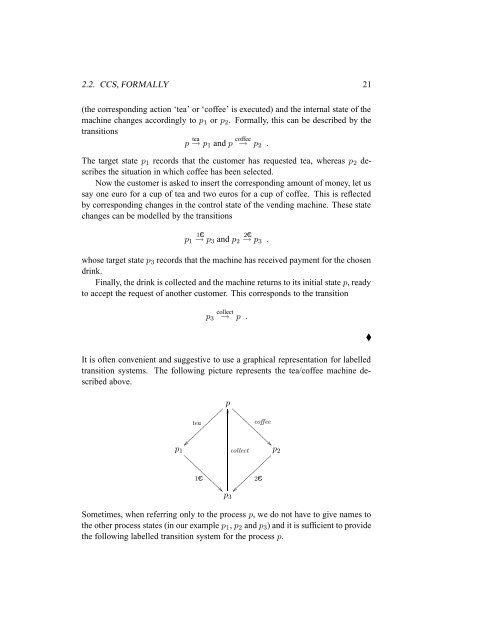Reactive Systems: Modelling, Specification and Verification - Cs.ioc.ee
Reactive Systems: Modelling, Specification and Verification - Cs.ioc.ee
Reactive Systems: Modelling, Specification and Verification - Cs.ioc.ee
Create successful ePaper yourself
Turn your PDF publications into a flip-book with our unique Google optimized e-Paper software.
2.2. CCS, FORMALLY 21<br />
(the corresponding action ‘tea’ or ‘coff<strong>ee</strong>’ is executed) <strong>and</strong> the internal state of the<br />
machine changes accordingly to p1 or p2. Formally, this can be described by the<br />
transitions<br />
p tea<br />
→ p1 <strong>and</strong> p coff<strong>ee</strong><br />
→ p2 .<br />
The target state p1 records that the customer has requested tea, whereas p2 describes<br />
the situation in which coff<strong>ee</strong> has b<strong>ee</strong>n selected.<br />
Now the customer is asked to insert the corresponding amount of money, let us<br />
say one euro for a cup of tea <strong>and</strong> two euros for a cup of coff<strong>ee</strong>. This is reflected<br />
by corresponding changes in the control state of the vending machine. These state<br />
changes can be modelled by the transitions<br />
p1 1C=<br />
→ p3 <strong>and</strong> p2 2C=<br />
→ p3 ,<br />
whose target state p3 records that the machine has received payment for the chosen<br />
drink.<br />
Finally, the drink is collected <strong>and</strong> the machine returns to its initial state p, ready<br />
to accept the request of another customer. This corresponds to the transition<br />
p3 collect<br />
→ p .<br />
It is often convenient <strong>and</strong> suggestive to use a graphical representation for labelled<br />
transition systems. The following picture represents the tea/coff<strong>ee</strong> machine described<br />
above.<br />
p1<br />
p<br />
tea<br />
<br />
<br />
<br />
coff<strong>ee</strong><br />
<br />
<br />
<br />
<br />
<br />
<br />
1C= <br />
2C=<br />
<br />
<br />
<br />
<br />
collect<br />
p3<br />
Sometimes, when referring only to the process p, we do not have to give names to<br />
the other process states (in our example p1, p2 <strong>and</strong> p3) <strong>and</strong> it is sufficient to provide<br />
the following labelled transition system for the process p.<br />
p2
















